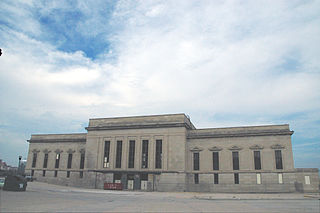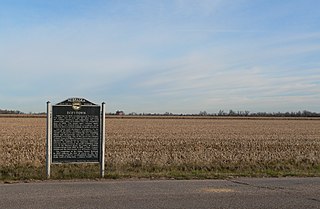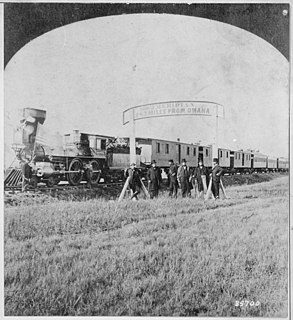Related Research Articles

North America's first transcontinental railroad was a 1,912-mile (3,077 km) continuous railroad line constructed between 1863 and 1869 that connected the existing eastern U.S. rail network at Council Bluffs, Iowa with the Pacific coast at the Oakland Long Wharf on San Francisco Bay. The rail line was built by three private companies over public lands provided by extensive US land grants. Construction was financed by both state and US government subsidy bonds as well as by company issued mortgage bonds. The Western Pacific Railroad Company built 132 mi (212 km) of track from the road's western terminus at Alameda/Oakland to Sacramento, California. The Central Pacific Railroad Company of California (CPRR) constructed 690 mi (1,110 km) eastward from Sacramento to Promontory Summit, Utah Territory. The Union Pacific Railroad (UPRR) built 1,085 mi (1,746 km) from the road's eastern terminus at the Missouri River settlements of Council Bluffs and Omaha, Nebraska westward to Promontory Summit.
Kearney or Kearneys may refer to:

Buffalo County is a county located in the U.S. state of Nebraska in the Midwestern United States. As of the 2010 United States Census, the population was 46,102, making it Nebraska's fifth-most populous of the 93 counties. Its county seat is Kearney. The county was created in 1855 and was organized in 1870. It was named after the once-prevalent buffalo herds.

Pleasanton is a village in Buffalo County in the state of Nebraska in the Midwestern United States. At the 2010 census, its population was 341.

The Chicago, Burlington and Quincy Railroad was a railroad that operated in the Midwestern United States. Commonly referred to as the Burlington Route, the Burlington, or as the Q, it operated extensive trackage in the states of Colorado, Illinois, Iowa, Missouri, Nebraska, Wisconsin, Wyoming, and also in Texas through subsidiaries Colorado and Southern Railway, Fort Worth and Denver Railway, and Burlington-Rock Island Railroad. Its primary connections included Chicago, Minneapolis–Saint Paul, St. Louis, Kansas City, and Denver. Because of this extensive trackage in the midwest and mountain states, the railroad used the advertising slogans "Everywhere West", "Way of the Zephyrs", and "The Way West".

The Missouri Pacific Railroad, commonly abbreviated as MoPac, was one of the first railroads in the United States west of the Mississippi River. MoPac was a Class I railroad growing from dozens of predecessors and mergers. In 1967, the railroad operated 9,041 miles of road and 13,318 miles of track, not including DK&S, NO&LC, T&P, and its subsidiaries C&EI and Missouri-Illinois.
The Kansas Pacific Railway (KP) was a historic railroad company that operated in the western United States in the late 19th century. It was a federally chartered railroad, backed with government land grants. At a time when the first transcontinental railroad was being constructed by the Central Pacific and the Union Pacific, it tried and failed to join the transcontinental ranks. It was originally the "Union Pacific, Eastern Division", although it was completely independent. The Pennsylvania Railroad, working with Missouri financiers, designed it as a feeder line to the transcontinental system. The owners lobbied heavily in Washington for money to build a railroad from Kansas City to Colorado, and then to California. It failed to get funding to go west of Colorado. It operated many of the first long-distance lines in the state of Kansas in the 1870s, extending the national railway network westward across that state and into Colorado. Its main line furnished a principal transportation route that opened up settlement of the central Great Plains, and its link from Kansas City to Denver provided the last link in the coast-to-coast railway network in 1870. The railroad was consolidated with the Union Pacific in 1880, and its mainline continues to be an integral part of the Union Pacific network today.

The Central Branch Union Pacific Railroad was a railroad in the U.S. state of Kansas. Originally planned as a line from Atchison west into Colorado, and given federal land grants by the Pacific Railway Act of 1862 as one of the branches of the Union Pacific Railroad, it was left with a hanging end at Waterville, Kansas when the Union Pacific Railway, Eastern Division, with which it was to connect, changed its route. The line was acquired by the Union Pacific through a stock purchase by Jay Gould and leased to the Missouri Pacific Railroad in 1880. In 1909 the Central Branch was merged into the Missouri Pacific; the latter company came back into the Union Pacific system in 1982. In 1991 the remaining trackage west of Frankfort was leased to the Kyle Railroad.
The Brandon Railroad is a switching and terminal railroad that operates 17.3 miles of former South Omaha Terminal Railway track outside of Omaha, Nebraska. This railroad started out as the Union Stock Yards Company of Omaha in 1897. In July 1927 it became the South Omaha Terminal Railway and then was taken over by the BRAN in 1978. The BRAN has connections to the BNSF Railway and the Union Pacific Railroad.
The South Omaha Terminal Railway in Omaha, Nebraska was a subsidiary of the Union Stock Yards Company of Omaha. Until the separate railroad company was created in July 1927, the trackage, about 17 miles (27 km), was owned and operated directly by the Union Stock Yards Company of Omaha. On April 4, 1978, an Interstate Commerce Commission emergency service order was issued at which time the Brandon Corporation took over service.
The Fremont, Elkhorn and Missouri Valley Railroad (FE&MV), sometimes called "the Elkhorn," was a railroad established in 1869 in the state of Nebraska in the Midwestern United States.

The Burlington and Missouri River Railroad (B&MR) or sometimes (B&M) was an American railroad company incorporated in Iowa in 1852, with headquarters in Omaha, Nebraska. It was developed to build a railroad across the state of Iowa and began operations in 1856. It was acquired by the Chicago, Burlington and Quincy Railroad in 1872, and kept serving as its subsidiary.
The Midland Pacific Railway was a railroad operating in the Nebraska counties of Lancaster, Nemaha, Otoe, Seward, and York.
The Omaha and Republican Valley Railway was a branch line of the Union Pacific that crossed Nebraska. Traversing several counties, including Buffalo County, the Railway was the impetus for several settlements, and upon its demise, several ghost towns. The Railway ran from Boelus to South Ravenna, to Poole and on to Pleasanton, Nebraska.

Railroads in Omaha, Nebraska, have been integral to the growth and development of the city, the state of Nebraska, the Western United States and the entire United States. The convergence of many railroad forces upon the city was by happenstance and synergy, as none of the Omaha leaders had a comprehensive strategy for bringing railroads to the city.

William Henry Baldwin Jr. was a president of the Long Island Rail Road from Boston, Massachusetts. He graduated from Harvard University in 1885 and studied law there for a year afterward. He was instrumental in establishing African American industrial education by securing sizable donations from Northern industrial magnates. Baldwin became a trustee of Tuskegee University in 1894 where he worked alongside Booker T. Washington. The son of a prominent Bostonian, William Henry Baldwin Sr., he carved out a successful career for himself in the railroad industry and gave generously of his time and money to the education of former slaves.

The Overland Route was a train route operated jointly by the Union Pacific Railroad and the Central Pacific Railroad / Southern Pacific Railroad, between Council Bluffs, Iowa / Omaha, Nebraska, and San Francisco, California over the grade of the first transcontinental railroad which had been opened on May 10, 1869. Passenger trains that operated over the line included the Overland Flyer, later renamed the Overland Limited, which also included a connection to Chicago. Although these passenger rail trains are no longer in operation, the Overland Route remains a common name for the line from Northern California to Chicago, now owned entirely by the Union Pacific.

Dobytown is a ghost town in Kearney County, Nebraska, United States, three miles west of Fort Kearny. Officially named Kearney City, the community was established in 1859. The town was given the common name of Dobytown because it contained mostly adobe buildings. Although the community no longer exists, the site was added to the National Register of Historic Places in 1974. The site is located at an altitude of 2,129 feet (649 m).

The history of the Union Pacific Railroad stretches from 1862 to the present. For operations of the current railroad, see Union Pacific Railroad; for the holding company that owns the current railroad, see Union Pacific Corporation.
References
- Holmgren, Philip S. "KEARNEY & BLACK HILLS RAILWAY A Backward Glance" . Retrieved 2012-08-05.
- Athearn, Robert G. (1971). Union Pacific country. Lincoln: University of Nebraska Press. pp. 373–374. ISBN 0-8032-5829-1.
- Union Pacific Railway Company (1896). The Union Pacific Railway and auxiliary companies: manual of annual meetings, directors, officers, capital stock, funded debt, etc. p. 32.